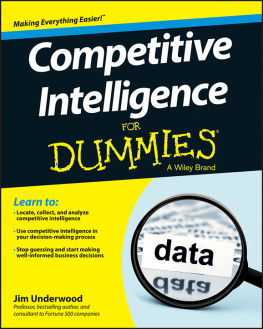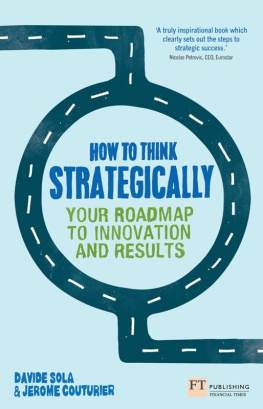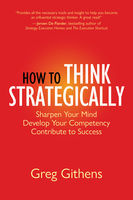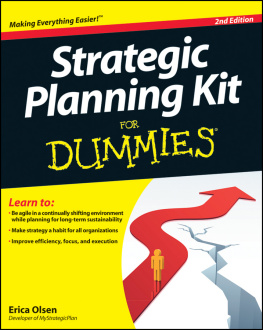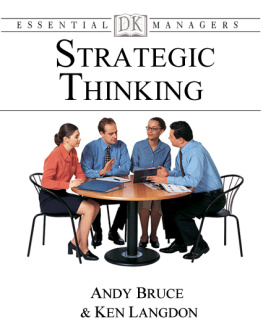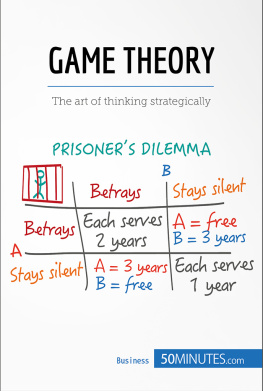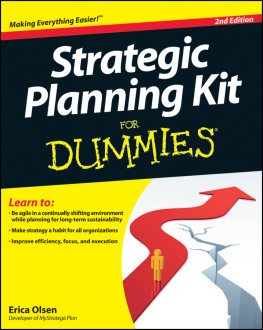Think Strategically

Xavier Gimbert
Associate Professor, Business Policy Department, ESADE Business School


Xavier Gimbert 2011
All rights reserved. No reproduction, copy or transmission of this publication may be made without written permission.
No portion of this publication may be reproduced, copied or transmitted save with written permission or in accordance with the provisions of the Copyright, Designs and Patents Act 1988, or under the terms of any licence permitting limited copying issued by the Copyright Licensing Agency, Saffron House, 6-10 Kirby Street, London EC1N 8TS.
Any person who does any unauthorized act in relation to this publication may be liable to criminal prosecution and civil claims for damages.
The author has asserted his right to be identified as the author of this work in accordance with the Copyright,
Designs and Patents Act 1988.
First published 2011 by
PALGRAVE MACMILLAN
Palgrave Macmillan in the UK is an imprint of Macmillan Publishers Limited, registered in England, company number 785998, of Houndmills, Basingstoke, Hampshire RG21 6XS.
Palgrave Macmillan in the US is a division of St Martins Press LLC, 175 Fifth Avenue, New York, NY 10010.
Palgrave Macmillan is the global academic imprint of the above companies and has companies and representatives throughout the world.
Palgrave and Macmillan are registered trademarks in the United States, the United Kingdom, Europe and other countries.
ISBN 9780230284876 hardback
This book is printed on paper suitable for recycling and made from fully managed and sustained forest sources. Logging, pulping and manufacturing processes are expected to conform to the environmental regulations of the country of origin.
A catalogue record for this book is available from the British Library.
A catalog record for this book is available from the Library of Congress.
10 9 8 7 6 5 4 3 2 1
20 19 18 17 16 15 14 13 12 11
Printed and bound in Great Britain by
CPI Antony Rowe, Chippenham and Eastbourne
To Bea, Laura and Sergi
CONTENTS
LIST OFFIGURES
INTRODUCTION
Thinking is what sets human beings apart from the rest of the animal kingdom. And thinking is what distinguishes each individual human from all the others. We think differently, and that makes us different people, because it also makes us do things in a host of different ways. Companies differ too, due to the fact that they think differently and therefore act differently; their thinking is strategically different insofar as they follow a wide variety of strategies.
There is no denying that companies are different, and very much so, in what they own, the resources they possess (technology, know-how, intangibles such as the brand, money, buildings, facilities). However, if we are thinking about future competitive advantages, the most basic resource will be one that is not included in the list above: people. The above resources are certainly essential, but strategic thinking and the knowledge and skills of the people in the organization are what will lead on the company into the future. It is people who get the company moving. A powerful car with a bad driver will be overtaken by a less powerful one with a great driver, even if the first has a big lead.
This explains, for example, how Apple dethroned IBM when it spent 100 times less than its competitor on R&D. Business history is replete with examples of David slaying Goliath on the basis of his strategic ingenuity.
Rest assured: if you think strategically better than your competitors, your company will win the competitive battle in the mid or long term. No matter how superior your competitors may be today, no matter how substantial their resources may be at present, do not be discouraged. Think, think strategically. That is the essential resource. It doesnt cost money, but money cant buy it. Its the key.
The aim of this book is to help you think strategically. It explains simply and clearly the elements, concepts, analyses and interrelationships that make up this strategic thinking. Moreover, it offers thinking models as guides to this process.
Just as companies need to be different in order to achieve a competitive advantage, to have some characteristic feature that better matches their customers needs, this book seeks to achieve the same. It has been written with the aim of being different from other books, to satisfy differently the need for knowledge of strategic management that is felt by entrepreneurs, managers and students of business administration at its various levels (undergraduate, MBA and executive programs).
From the start, this work has been conceived on the basis of a clear schema, a management model that is simple and straightforward to follow, each chapter being built on the foundation of the previous one. It provides easy explanations of the various strategic concepts and the complex interrelationships that exist between them. This is so because although the subject is complicated and dense it is set forth in such a way as to be up to date, didactic and clear. It contains constant references to companies and business situations. It also uses similes and metaphors that help the reader to understand each business perspective. It aims to be completely practical and useful, and, with this in mind, a series of questions for reflection are added at the end of each chapter. These questions are intended to facilitate the direct application to the company of the concepts, models and thoughts described in the body of the chapter.
In short, this book seeks to explain the keys to business management using a different style, a style that is easy to read, a world away from the typical tedious management handbooks, thus encouraging the reader to think about the fundamental concepts of company strategy.
This work is also an attempt to impart knowledge in a passionate way, by spreading the enthusiasm, the excitement and the thrill that is part and parcel of strategy. Strategic management has the capacity to change the direction of companies, it has the immense and wonderful power to transform, to innovate, to create. And remember that companies are the driving force behind the economy of countries and the world. As long ago as the mid-1990s, Richard Branson, creator and owner of Virgin, said: People think politicians can change the world, but its not true. The only people who have real power are us businesspeople. This is the strength of strategic management. Exciting stuff indeed!
This book is the result of more than 25 years of work by the author in the academic and business worlds. It is the consequence of his experience in both. It is also the fruit of his development as a writer and his reflections as an academic, manager and author, especially since 1998, when he published his first books and his answers to the new business world with which we must learn to live, in the wake of the deep economic and financial crisis of 20072011.
These personal visions and strategic models, together with the straightforward language with which the author confronts the complexity of strategy today, seek to endow this work with a distinctive hallmark. In the face of increasing complexity in the business environment, the answer is a clear and structured strategic vision of this complicated and confusing reality. Only in this way can it be subjected to the constant monitoring that this complexity demands.
Next page

